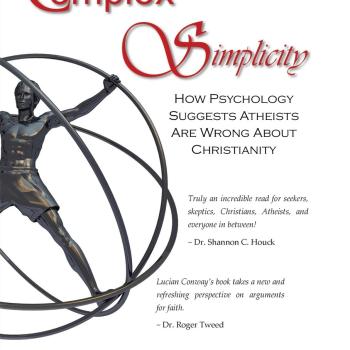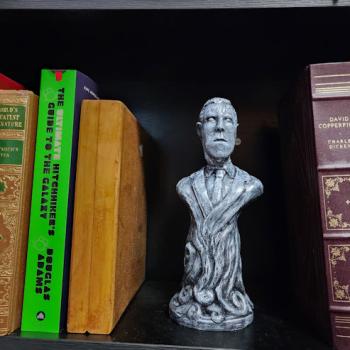The Beginning of High Profile Deconversion
In modern times, the first high-profile Christians to make waves in the news with their very public deconversions were, perhaps, the Gungors – husband-and-wife performers who gained a high degree of recognition and toured the world with their Christian music. Their public proclamation in 2014 that they no longer believed the Bible, according to the Christian Post, “stunned the Christian community,” however Michael Gungor later admitted that he had been an atheist since 2012. Lisa Gungor’s journey has taken her solidly away from Christianity, but not fully into atheism as of her latest public statements.
A few years prior, Hemant Mehta, the “Friendly Atheist,” surrendered his Patheos blog to guest writer Rachael Slick. Slick may not have been as well-recognized as the Gungors, but her father was a mover and shaker in the world of Christian Apologetics. Her article detailed her journey into atheism. Around the same time, Leo Behe, son of a high-profile biologist, Christian, and advocate for Intelligent Design, also came out publicly as a deconvert.
To seal the significance of the situation, in 2015 the Pew Research Center released its first report on the shrinking population of Christians in America.
Just these few public proclamations of deconversion were enough to catch broad attention, raising the hopes of the still-strong “New Atheist” community, while causing despair in Christian circles. Not coincidentally, it was around this time that the first significant research into Christian deconversion began to see publication. In this article, I will trace the history and trends in this research.
The Personality of Deconversion
In their 2004 paper “The Variety of Deconversion Experiences: Contours of a Concept in Respect to Empirical Research” researchers Streib and Keller noted the severe lack of research devoted to the subject of deconversion compared to the increase in interest in the phenomenon. In their examination of the existing literature, Streib and Keller noted that openness to new experiences and the tendency to value experience over belief were recognized as being similar features in religious exiters. Later, in 2021, Streib presented further data to support these results from more current research he performed in his native Germany.
Streib and Keller noticed that deconversion often began with life difficulties. The potential deconvert would look to his or her religious environment for solutions, and find very little help on that front. Surprisingly, there is a strong connection here to religious conversion. It has long been recognized that an individual who experiences life difficulties enters a problem-solving process called “seeking” (Rambo, 1995). During this period as a “Seeker” the individual is more willing to step outside of previous comfort zones and explore solutions previously not considered or even rejected (Malony, H. N., Southard, S. 1992). In this instance, what is true of the religious convert appears to be true of the deconvert as well: problems make people look for solutions. If the solutions are not at hand in your current environment, you seek out new environments.
Connections to the “Emergent Church”
Another observation of Streib and Keller’s was that deconverts tend to value experience over belief (Streib and Keller, 2004). Other studies from Harrold (2006) and Bielo (2012) observed that in the “emerging” church of the early 2000s, deconversion narratives replaced conversion narratives as the form of religious “testimony” (Bielo, 2012). Whereas individuals belonging to the Emerging Church (EC) still considered themselves Christians, this brand of Christianity was characterized by the rejection of the Evangelical church and of an attitude of suspicion toward Evangelical religious notions (Bielo, 2012). Doubts, not beliefs, were held as virtuous, and pastors spent more time deconstructing religious doctrines and questioning biblical texts than they did supporting a religious position or exegeting biblical texts (Harrold, 2006). In this respect, the “testimonies” of EC members resembled in their construction the “exitmonies” of deconverts by way of emphasizing criticisms of the Evangelical Church, problems experienced with their previous religious understandings, doubts, and the experience of leaving their previous religious community. The difference between EC members and deconverts being that doubts were considered religious virtues by EC members (Harrold, 2006), but legitimate reasons to exit religion by deconverts (Perez and Valierez, 2019).
Fundamentalism and Deconversion
In researcher Raoul J. Adam’s 2009 paper “‘Leaving the Fold’: Apostasy from Fundamentalism and the Direction of Religious Development,” the researcher made a crucial observation about the religious background and environment shared by most deconverts: that they primarily emerged from a Fundamentalist church background. For Adam, Fundamentalist churches were distinct in their way of fostering the obligation to be certain about one’s beliefs – any uncertainty being characterized as religious failure.
How Does Atheism Emerge from Religion?
A little prior to the rise of deconversion research, atheist researchers Norenzayan and Gervais (2013) chose to tackle the phenomenon from a different angle.
It has long been recognized that human societies are almost always religious in some way. So the two researchers had to ask the question “in a world full of religious believers, where does religious disbelief come from? This is not to say that societies are religious necessarily. As observed by sociologist Gregory S. Paul (2010), religion isn’t an essential part of all cultures, and some hunter-gatherer tribes in Africa have been observed to have little more than basic animistic beliefs. However, those cultures which are religious – which include the majority of cultures at some stage in their history – may see religious dissent, but rarely unbelief in its raw, atheistic form (Norenzayan and Gervais, 2013). Consequently, these researchers set out to discover the origins of religious disbelief. They came to the conclusion that the emergence of religious disbelief in cultures was the result of at least four pathways: “Mind-blind,” meaning individuals who simply do not understand religion, “Apatheism” simply fails to acquire interest in religion, “Incredulous Atheism,” finds religion unbelievable, and “Analytic Atheism” identifies inconsistencies and problems within the religious belief system. Given that this was more of a sociological study than a psychological one, the application to individual deconversion is not direct, however it correlates well with other studies such as that of Streib (2021) who identifies similar features – most notably the tendency toward analytical thought styles – with deconversion. In their Grounded Model approach, researchers Sergio Pérez and Frédérique Vallières (2019) identified cumulative factors of “reason and enquiry,” “criticism and discontent,” and “personal growth and development” as causal factors in deconversion, which also aligns well with the findings of Norenzayan and Gervais (2013).
The Connection Between Religious Education and Deconversion
In The Humanist article “Mental Leaps,” Fetters (2014) reflects on her personal experience in the religious education system and lays the blame for deconversion on the unbelievability of ideas impressed upon her as a child growing up within that system. This included linking all aspects of thought and development back to the spiritual, the moral strictures taught by the system, and, most notably, the pseudoscience of Creationism. When a child reared in such an environment is exposed to the “real world,” this person will identify the problematic nature of the religious teachings and reject them for the more sensible secular alternative (Fetters, 2014).
This focus on Creationist science as the driver behind deconversion is also asserted by Gregory S. Paul in his contribution to the collaborative academic volume Atheism and Secularity Volume 1: Issues, Concepts, and Definitions (Zuckerman, 2010). In his chapter, “The Evolution of Popular Religiosity and Secularism: How First World Statistics Reveal Why Religion Exists, Why it has been Popular, and Why the Most Successful Democracies are the Most Secular,” Paul attributes the drift from religion to secularism primarily to the development of science in a religious culture which embraces Creationism as its fundamental premise: religious belief which stands or falls on Creationism will fall in the light of scientific development (Zuckerman, 2010, pp 149 – 207). Atheist personality Rhett James McLaughlin also credits Creationism and its failures to measure up to rigorous scientific investigation as instrumental in his deconversion.
Researcher James Michael Nagle (2017) also credits some trends toward deconversion to religious education, but takes another approach (Nagle, 2017). Argues Nagle, “…some effective educators are inviting students to explore the diversity they live and witness, and to test what is good. Some religious educators might intuit the false distinction between these two sides. As a result, they may be less interested in reproducing an adherence of religious education or handing on a theology of affiliation but instead hope to support learners’ abilities to form and practice their own values, feelings, and meaning that may include hybrid religious identities, multiple belonging and rejection of some religious teachings.” (Nagle, 2017, pp. 259 – 260). Essentially, Nagle is arguing that religious education is adopting a postmodern approach, moving away from exclusivism, giving students permission to explore pluralism, “tinker,” and come to irreligious conclusions (Nagle, 2017). This approach is suggestive of the experience of Ryan Bell, who “tried on” atheism and found that it was consistent, and of the work of Harrold (2006) and Bielo (2012) in their research on the Emerging Church cited earlier in this section. Atheist Rachael Slick, argued that it was the very rigor of critical thinking impressed upon her by her Christian Apologist father which caused her to question her religious beliefs.
Problems Which Lead to Deconversion
Perhaps one of the most recognized modern deconversion researchers is Dr. John Marriot of Biola University. In his 2014 dissertation The Cost of Freedom: a Grounded Theory Study of the Impact of Deconversion from Christianity to Atheism (Marriot, 2014), Marriot uses a Grounded Research method to develop a model of deconversion based on a series of interviews with deconverts. In this dissertation, Marriot begins by identifying factors which contribute to deconversion. The first he identifies is the failure of the church environment, including hurtful actions of Church leaders and of fellow Christians and the way in which the Congregation responds to these hurtful actions. The second he identifies is disappointment with God. After this, Marriot, like Streib (2021) and Pérez and Vallières (2019), identifies certain cognitive factors with deconversion. Marriot specifically finds that problems with the Bible are prominent objections to the Christian religion. The specific Biblical objections identified by Marriot include the problem of inerrancy, morally objectionable material, and the scientific evidence for Darwinian Evolution. This attribution to Biblical problems aligns with the findings of Starr et al (2019), and regarding problems with Creationism versus Evolutionism, is well supported by the research of Fetters (2014) and Paul (Zuckerman, 2010) mentioned earlier in this section. Marriot’s next contributing factor the influence of atheists in cultivating doubts, especially aided by the availability of anti-Christian material and individuals on the internet. This attribution to internet usage as a contributing factor in deconversion is supported by the work of Paul McClure (2017), who concludes that internet usage increases the probability of “tinkering.” Says McClure, “Tinkering means that people feel they’re no longer beholden to institutions or religious dogma …Today, perhaps in part because many of us spend so much time online, we’re more likely to understand our religious participation as free agents who can tinker with a plurality of religious ideas—even different, conflicting religions—before we decide how we want to live.” (McClure, 2017). This is not unlike the conclusion given by Nagle (2017) above.
Stages of Deconversion
After identifying these common religious objections, Marriot then develops a model of deconversion in his paper. His model breaks down into five stages. The first of these stages is Crisis followed by the second stage of Truth Seeking. These initial two stages are nearly identical to what has long been recognized in religious conversion modeling, beginning as early as William James (1902). James accorded the impetus for religious seeking as a result of a deeply affecting numinous experience which results in either a “sick soul” response, wherein the person feels convicted of sin, evil, or various personal failures, and pursues religion as an antidote to these failures; or to a “healthy mind,” wherein the person finds value in religion as a method of maintaining personal harmony (James, 1902). This idea of a crisis leading to conversion has long been supported by researchers such as Lofland and Stark (1965), whose acclaimed conversion model began with a feeling of deep instability followed by a period of “seeking” (Lofland and Stark, 1965). Marriot’s deconversion model is similar, in that the individual discovers a problem which appears to be irreconcilable within that person’s religious context, and consequently begins seeking for solutions external to the religion (Marriot, 2014).
The third stage of Marriot’s model is the individual’s attempt to retain his or her religious belief. This is followed by stage 4, wherein the person becomes “agnostic,” insofar as he or she enters the mindset that they cannot know the truth about religion or beliefs. The final stage is a transition to atheism, which is gradual and comes as a sort of “dawning realization” that he or she does not believe (Marriot, 2014).
In a development of several themes discussed above, Starr, Waldo, and Kauffman (2019) conducted a study titled “Digital irreligion: Christian deconversion in an online community,” (Starr, Waldo, and Kauffman, 2019) in which they gathered “exitmonies” from an online forum wherein deconverts were encouraged to share their deconversion narratives. The objective was to discover the role of the Internet in accelerating the secularization of the United States. Similar to the findings of Sergio and Vallières (2019), and of Streib and Keller (2004), Starr et al found that intellectual, emotional, and social processes all intertwined in a combination that resulted in deconversion. As for the role of the internet, the shared online space allowed these individuals to create a community outside of their religious sphere wherein they could cultivate an irreligious identity, to associate with others who had the same difficulties and religious objections as themselves, and to explore and develop those objections in the context of an online community. The other method in which internet communities facilitated the process of deconversion was that it gave the deconvert methods with which to interact with religious believers in an offline context given their new secular identity and religious objections (Starr et al, 2019).
The Deconversion Crisis
Fazzino, in his 2014 article “Leaving the church behind: applying a deconversion perspective to evangelical exit narratives,” re-treads old ground in identifying contributing factors to deconversion, but breaks new ground in the discussion of the deconversion event itself and the post-deconversion crisis that follows. Says Fazzino, “Exiting Evangelical Christianity often resulted in the loss of family and peer groups and was a catalyst for negative emotional experiences. Clearly, the participants were not trying to maximize the benefits or minimize the costs associated with exiting religion, as rational choice theory suggests. Participants no longer had a sincere conviction of the cultural repertoire of Evangelical Christianity. Rather than continually deliver inauthentic, albeit socially acceptable, displays of beliefs, deconversion was motivated by participants’ intellectual, social, and emotional commitments. Despite the risks associated with deconversion, the non-believers in this study displayed a commitment to authenticity,” (Fazzino, 2014).
The social difficulty with exiting religion is also emphasized in the 2020 American Atheist Society study titled “Reality Check: Being Nonreligious in America” (Frazer, El-Shafei, and Gill, 2020). This study was the result of an online survey garnering thousands of responses in which it was determined that atheists experienced feelings of persecution and social marginalization similar to that reported by other minorities and members of the homosexual community. This resulted in a sort of “coming out” experience, wherein the atheist reveals to friends and family that they are now unbelieving, followed by the adjustment (or failure to adjust) of the religious community to the individual’s new identity. Ultimately, the individual would tend to be alienated from the former community (Frazer et al, 2020). What Fazzino argues is that this results in a shifting of identity and of loyalty to the irreligious community whose commonality revolves around their collective experience of rejecting religion and experiencing abiding personal problems with religion (Fazzino, 2014). Frazer et al (2020) expand on this by concluding that the growing atheist community, composed largely of religious exiters, became strongly politically active, and attempt to resolve their difficulties with religion by way of political activism.
Is the Church too Primitive for the Modern World?
Researchers such as Norenzayan, and Gervais (2013), Streib (2021) and Pérez and Vallières (2019) have identified things such as analytical thinking and openness to new experiences as contributing to deconversion, and others such as Fetters (2014) and Paul (Zuckerman, 2010) identified scientific progress weighed against the pseudoscience of the church as contributing to deconversion. In their study, “An integrative complexity analysis of religious and irreligious thinking,” (Shannon, Lucian, Kimberly, Alex, and Joeann, 2018) researchers Shannon, Lucian, Kimberly, Alex, and Joeann (2018) suggested that there is a common notion that religious people are simplistic and unsophisticated thinkers, whereas atheists are sophisticated and complex thinkers. In order to test this, the researchers conducted an integrative complexity analysis of writings and speeches given by Christians against those given by atheists within the span of about 100 years. They conducted three complexity analyses. The first involved an examination of the writings and speeches of prominent atheist and Christian thinkers in different eras dating back to the early 20th century up until the current day. These thinkers were separated into contemporaries and then divided against one another, and then tested for complexity of thought as judged by their writings and speeches. The second test collected papers about personal values gathered by an international essay organization. Hundreds of essays were collected and divided based on usage of religious language. The same complexity analyses were performed on the religious versus irreligious essays. The final test involved taking the writings of famous author and thinker C. S. Lewis and separating them into writings and speeches he gave while he was an atheist compared against those while he was a Christian.
The findings of these three tests suggested that Christians scored as equal to atheists in complexity of thought on certain metrics and slightly out-scored atheists on others, suggesting that the notion that Christians were simplistic, black-and-white thinkers was erroneous, or at least an unjustifiable generalization. When placed in context alongside the findings of Adam (2009) about the primacy of Fundamentalist churches – with their focus on ideological certainty – as producers of deconverts, this may suggest that it is the anti-intellectual religious environment when placed in contact with more sophisticated, questioning, and truth-seeking behavior which may contribute to the move to deconversion.
The method in which the religious environment may have some causal power toward deconversion is expanded in Łysiak, Zarzycka, and Puchalska-Wasyl’s 2020 study titled “Deconversion Processes in Adolescence—The Role of Parental and Peer Factors”. As the title suggests, this study examined the relationships between deconverts and their parents and peers in order to identify what kinds of relationships could be predictors of deconversion. The researchers found that, firstly, deconversion is particularly prominent in young people. It has long been recognized that religious adoption and abandonment is most prominent during adolescence – with research to this effect extending back as far as James (1902) up to Gooren (2010). This being so, Lysiak et al determined that if parents were both religious and caring, this decreased the probability of religious abandonment. Similar results were found regarding supportive peer groups. The more available and supportive the peer group, the less likely the individual was to adopt moral criticisms of religion, and to abandon religion (Lysiak et al, 2020).
Conclusion
This article gives a whirlwind tour of the major findings in deconversion research as of this time, and re-treads some old ground from previous articles I have written. Likely I will dive more in-depth into some of the research mentioned here, however for those interested in a summary of where we researchers stand at this time, this article should be a very good one-stop resource.



















